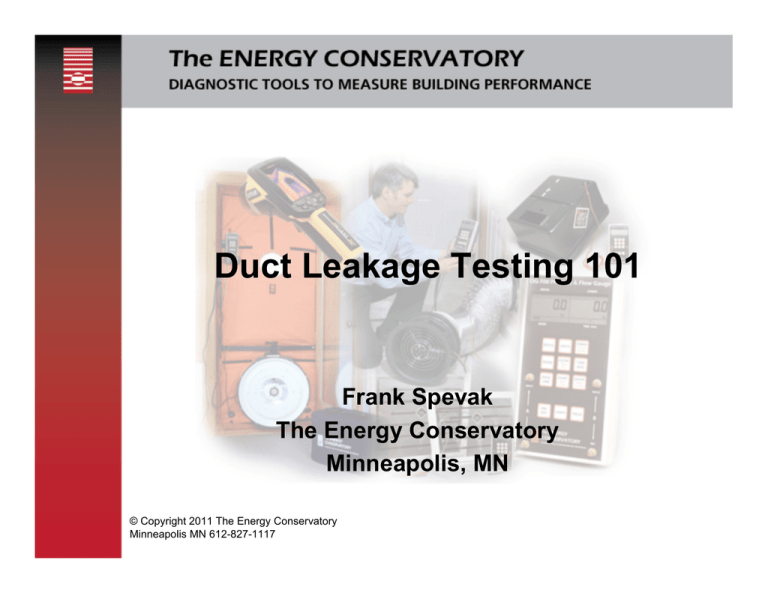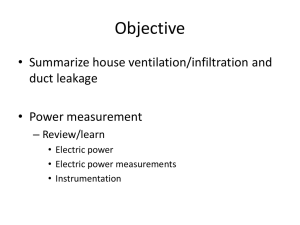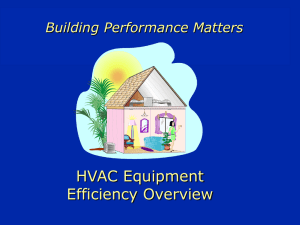Duct Leakage Testing 101 - The Energy Conservatory
advertisement

Duct Leakage Testing 101 Frank Spevak The Energy Conservatory Minneapolis, MN © Copyright 2011 The Energy Conservatory Minneapolis MN 612-827-1117 Housekeeping • If you do not hear anything from your computer’s speaker system you will need to dial in and listen to the presentation over the phone • If you have a question or a comment about the presentation, please type your message in the box at the lower right hand portion of the screen • If the image is larger than your screen you have scroll bars on the right and bottom to position the screen for your best viewing • Copies of the slides will be on The Energy Conservatory website in about 2 weeks Housekeeping • If you lose your connection, close your browser, restart your browser and then join the webinar again • BPI credits can only be issued for attending a live broadcast of the webinar • If you wish to receive BPI credits for this webinar, you will need to make sure that your name is registered for the webinar • BPI will be notified of your attendance in about a week • You will also need to send an email to info@energyconservatory.com with your name and BPI certificate number Agenda • Duct Leakage and Interactions • Types of Duct Leakage Tests – Total Duct Leakage – Duct Leakage to Outside • • • • • Set-up for Total Duct Leakage Set-up for Duct Leakage to Outside Discussion of Leakage Results Duct Blaster® Calibration Other Tests Using a Duct Blaster® Duct Leakage Interactions Common Leakage Locations Common Leakage Locations Types of Duct Leakage Tests • Total Duct Leakage – Pressurize (or depressurize) duct work. – Duct Blaster® connected to central return or air handler. – Measure air flow (CFM) needed to pressurize ducts to 25 Pa. – Measures all duct leaks. Total Leakage Test • Measures all leaks in the duct system, both inside and outside of the building. Types of Duct Leakage Tests • Duct Leakage to Outside – Pressurize (or depressurize) duct work. – Duct Blaster connected to central return or air handler – Blower Door operating to pressurize house to 25 Pa. – Measure air flow (CFM) needed to equalize pressure in ducts to 0 Pa. – Measures only duct leaks to outside the building envelope (e.g. attics, crawlspaces, garages). Outside Leakage Test • Does not include duct leakage to inside the building. Total vs. Outside Leakage Test Total Leakage Test: Pro: – – – Con: – Can do test at rough-in. Shorter set-up time/easier test. Less equipment needed. Often results in larger leakage measurement than Outside test (unless all ducts are outside of the building). – Harder to meet Energy Star requirements if leakage number is bigger. – If testing at rough-in, often have to accept penalty for missing register grilles (2.5%), and missing air handler (2.5%). Total vs. Outside Leakage Test Outside Leakage Test: Pro: – Often results in smaller leakage measurement than Total test (unless all ducts outside). – Easier to meet Energy Star requirement if leakage measurement is smaller. Con: – Longer set-up time. – More equipment needed (Blower Door). – Must wait until building envelope completed before conducting test. Total Leakage Test (Pressurization) Conducting a Total Leakage Test Total Leakage Test • Connect the Duct Testing Fan to either: – The largest return grille, or – The blower access door. Total Leakage Test • Install the Flow Ring on the fan that you think best matches the needed fan flow (can always change Ring during test). Fan Configuration Open (no Flow Ring) Ring 1 Ring 2 Ring 3 Flow Range (cfm) For Series B Duct Blaster 1,500 - 600 800 – 225 300 – 90 125 – 10 Total Leakage Test • Turn off the air handler so that it does not come on during test. • Temporarily seal off all remaining supply and return registers using painters tape, Duct Mask or other temporary seal. Total Leakage Test • Turn off exhaust fans, dryers etc. • Remove all filters from the duct system. • Open a door or window between the house and outside (prevents changes in house pressure during the test), and interior doors. • Open access doors from unconditioned spaces (e.g. attics) containing ducts to outside. Total Leakage Test • Select a location to measure duct pressure. – Either in the supply plenum, supply trunkline, or at a supply register. – In a tight duct system (i.e. < 200 CFM25), location choice will have very little effect on results. – In zoned systems, must have dampers open, or will need to test each supply run separately (this is a big problem). Total Leakage Test • Connect tubing to the DG700 Gauge. – Green tubing from duct pressure probe to Input of Channel A. – Red tubing from Duct Blaster fan to input of Channel B. Total Leakage Test • Put DG-700 in PR/ FL @25 Mode, enter Device and Configuration, adjust fan to about 25 Pa duct pressure on Channel A. – Gauge displays CFM25 on Channel B. (Can’t Reach 25 Factor is built-in to the flow reading) – Saves time - no need to adjust test pressure to exactly 25 Pa - just get close (20 - 30). – In very leaky duct systems, displays leakage estimate if Duct Pressure is at least 5 Pa. Outside Leakage Test (Pressurization) Outside Leakage Test • When possible, unconditioned zones containing ducts shall be opened to outside and conditioned zones containing ducts shall be opened to inside. If this is not possible, leave as is. • Windows and doors to outside must be closed. • Prepare house for a Blower Door test. – Water heater on pilot. – Turn off heating and cooling system. Outside Leakage Test • Seal off all registers and returns as in a Total Duct Leakage Test. • Duct Testing Fan set up is the same as Total Leakage Test. • Install Blower Door fan to pressurize house (not measuring flow from Blower Door fan). Outside Leakage Test (Blower Door) • Start DG-700 gauge on the Blower Door and go to the Cruise Mode. • Set for 25 Pa. • Start fan to maintain house at 25 Pa. Outside Leakage Test • With Duct Blaster DG-700, connect tubing to the gauge (same as Total Leakage Test). – Green tubing from duct pressure probe to Input of Channel A. – Red tubing from Duct Blaster fan to input of Channel B. Outside Leakage Test • Put DG-700 in PR/ FL Mode (not PR/ FL @25), enter Device and Configuration. • With Blower Door pressurizing building to 25 Pa, adjust Duct Blaster to create zero pressure between ducts and building (Channel A). Flow value from Channel B is the measured leakage. Tips and Troubleshooting • When performing a Leakage to Outside Test, perform a Total Leakage Test first to determine if house passes without the Outside Test. • Also provides you with an maximum leakage number. The Outside Test can not have a number larger than the Total Test. • Remember, for Outside Test, have the gauge in PL/FL mode not PL/FL@25 mode – common error. Leakage Results • Any duct leakage that is outside of the building envelope creates an energy penalty as well as air quality problem. • Duct leakage to the inside is not a large energy penalty, but can contribute to problems related to delivery of air, comfort issues and other problems related to pressurization or depressurization of the house. • Be aware that sealing all ductwork can cause other problems related to the air handler or combustion safety. Leakage Results • How much duct leakage is acceptable? • Use California as example (all ductwork is usually outside building envelope) – For Retrofit • Total duct leakage can not exceed 15% of rated flow of air handler, or • Reduction of total duct leakage by 60%. (Requires a pre test of duct leakage) • Energy Star – For New construction • 6 cfm leakage to the outside per 100 sq. ft. of floor area. Leakage Results • How much leakage are we talking about? • Retrofit: – House system has 2 ½ tons of cooling. – At 400 CFM per ton equals 1,000 CFM. – Retrofit @ 15% = 150 CFM25 of total leakage. • New construction: – 1000 square feet – Energy Star @ 6% equals 60 CFM25 of leakage to the outside Duct Leakage Impacts • Example – – Outside duct leakage test results are 300 CFM25 on a 2 ½ ton system. – Assuming the leaks are split equally between supply and return, the result is a 22.5% annual energy penalty. – A 12 SEER system is now only 9.3. – An 80% furnace is now only 62%. • Duct Leakage to Outside is a direct energy penalty for heating and cooling. Duct Blaster Field Calibration Plate • Used to perform a field calibration check on your Series B Minneapolis Duct Blaster System (with DG700 gauge). • Designed to simulate a duct leakage test with a leakage rate of 106 CFM @25 Pa. Other uses of the Duct Blaster • Duct Blaster Fan can be used as a Blower Door. – Small, tight houses. – Need new nylon panel sized for the Duct Blaster Fan. Other uses of the Duct Blaster • Duct Blaster as Powered Capture Hood. – Accurately measure flow at supply or return registers. – Bulky, but very accurate and easily modified for unusual register locations such as toe kicks. Updates Coming to Duct Blaster® • New Digital Fan Speed Controller – allows user to perform an automated test • New rechargeable battery pack – allows user to perform lower flow tests without connecting to a wall outlet • New FlowBlaster™ add-on – to measure supply and return flows through registers and grills • Expected availability 2nd quarter 2011 • Pricing and updates will be on website and enewsletters Other Resources • Visit The Energy Conservatory website – – – – www.energyconservatory.com All manuals and literature. Training contacts and annual conferences. Duct Blaster Quick Guide Video. Thank you • Any further questions



